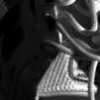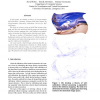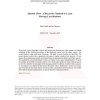ICCV
2005
IEEE
15 years 9 months ago
2005
IEEE
Lighting variation is commonly handled by methods invariant to additive and multiplicative changes in image intensity. It has been demonstrated that comparing images using the dir...
ICCV
2005
IEEE
15 years 9 months ago
2005
IEEE
The goal of deconvolution is to recover an image x from its convolution with a known blurring function. This is equivalent to inverting the linear system y = Hx. In this paper we ...
ICCV
2005
IEEE
15 years 9 months ago
2005
IEEE
We present a new approach to model visual scenes in image collections, based on local invariant features and probabilistic latent space models. Our formulation provides answers to...
ICCV
2005
IEEE
15 years 9 months ago
2005
IEEE
In this paper we develop a theory of non-parametric self-calibration. Recently, schemes have been devised for non-parametric laboratory calibration, but not for selfcalibration. W...
ICCV
2005
IEEE
15 years 9 months ago
2005
IEEE
This paper breaks with the common practice of using a joint state space representation and performing the joint data association in multi-object tracking. Instead, we present an i...
ICCV
2005
IEEE
15 years 9 months ago
2005
IEEE
Face recognition under varying illumination remains a challenging problem. Much progress has been made toward a solution through methods that require multiple gallery images of ea...
ICCV
2005
IEEE
15 years 9 months ago
2005
IEEE
The invariance of the similarity measure in photometric distortions as well as its capability in producing subpixel accuracy are two desired and often required features in most st...
ICCV
2005
IEEE
15 years 9 months ago
2005
IEEE
We present an algorithm for detecting multiple rotational symmetries in natural images. Given an image, its gradient magnitude field is computed, and information from the gradient...
ICCV
2005
IEEE
15 years 9 months ago
2005
IEEE
Most dense stereo correspondence algorithms start by establishing discrete pixel matches and later refine these matches to sub-pixel precision. Traditional sub-pixel refinement me...
ICCV
2005
IEEE
15 years 9 months ago
2005
IEEE




